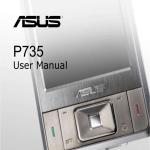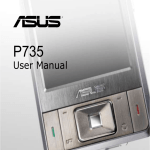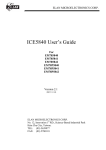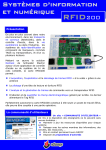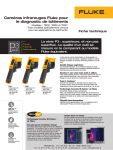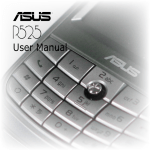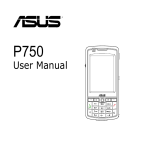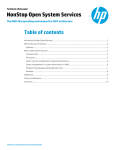Download Asus P735 User manual
Transcript
P735 Quick Start Guide Package contents Check your P735 package for the following items: P ASUS P735 device P Battery P AC Adapter P Mini-USB cable P Headset P Stylus P Protection case P Getting Started CD P User Manual P Quick Start Guide P Warranty Card NOTE: If any of the above items is damaged or missing, contact your retailer. CAUTION: • To reduce risk of fire, use only correct battery type. Refer to “Installing the SIM card and battery” section for details. • Do not attempt to disassemble the battery pack. • Dispose of used batteries properly. Inquire from local authorities for proper disposal of battery. Getting to know your P735 Layout 3 2 1 20 Top features 7 24 22 19 8 21 9 25 4 23 5 10 Right side features Rear features 12 16 6 11 13 Left side features 18 15 26 27 28 17 14 Front features Bottom features Device components description No. Item Description 1 MiniSD slot Allows you to insert a MiniSD storage card. 2 Power button Press to turn the power ON or to set suspend mode or to wake device from sleep mode. Press and hold to turn the power OFF. 3 Stylus Use the stylus to write, draw, or select items on the touch screen. 4 Camera/Shutter button Press to launch the camera. In camera mode, half-press to autofocus then full-press to take a picture. In video mode, full-press to start recording video and press again to stop. 5 Volume controller Press the arrow buttons to adjust the volume. 6 Reset button Using the stylus, press reset button to soft-reset your device. 7 Notification LED This multi-color LED notifies the following: • Green - Phone fully charged. • Flashing green - Network detected. • Red - Phone is charging. • Flashing red - Event notification. • Flashing blue - Bluetooth® or WLAN(IEEE 802.11b/g) ON. 8 Earpiece receiver Allows you to listen to incoming/outgoing calls. 9 Sub camera lens This sub camera is for the video conference. 10 LCD touch screen This 2.8-inch, 65536-color, 240 x 320-resolution, touchscreen TFT LCD allows you to write, draw, or make selections using the stylus. 11 Call key Press to receive an incoming call or make a call. 12 Left Soft key Performs the command indicated above the button. 13 Video call button Press to make video calls. Device components description No. Item Description 14 Navigation buttons Use to move through menus. Press the center to run an application or in camera mode, press to take a picture. 15 Action button Press to carry out the task of selected item. 16 Right Soft key Performs the task indicated above the button. 17 Mode/Task switcher button Allows you to switch applications and tasks. Press and hold this button to turn on/off the flashlight. 18 End key Press to end a call or GPRS Connection. 19 Camera flashlight Allows you to capture images in a dim environment. Press and hold the mode switcher button to turn this flashlight on/off. It works on today screen only. 20 Self-Portrait Mirror Position your device until this mirror reflects the image you want to capture. 21 Camera lens This 2-megapixel camera comes with Auto-Focus (AF) lens and flash light features. 22 Speaker Allows you to listen audio media and phone calls. 23 Battery compartment Contains the battery that supplies power to the device. 24 Voice Commander/record button Press to launch the voice commander. Press and hold to launch the record application to record voice. 25 Hold button Slide to enable or disable all keys including the LCD touch screen. 26 Earphone port Plug headset accessory to this port. 27 Mini-USB connector Use this connector to synchronize your data or to charge the battery. 28 Mic Used to make or receive phone calls, record sounds, record voice, or say voice commands. NOTE: The Voice Command utility is supported in selected languages only. Getting your device ready Before you can start using your device, you need to install a Subscriber Identity Mode (SIM) card and a charged battery. A SIM card contains your phone number, subscriber details, phone book, and additional phone memory. Installing the SIM card and battery 1. Remove the battery compartment cover then remove battery. 3. Insert the SIM card with its gold contacts facing down and the notched corner oriented to the upper left corner of the slot. 4. Replace the battery into the compartment with its copper contacts aligned to the copper conductor on the device. 5. Replace battery compartment cover. CAUTION: Use only an ASUS qualified battery for this device. Charging the battery The bundled battery pack is shipped partially charged. Make sure to charge the battery at least four hours before using it for the first time. To charge the battery: 1. Connect the AC adapter plug to the mini-USB connector at the bottom of the device. 2. Connect the AC power plug to a grounded wall socket or power strip. The LED indicator turns red while the phone is charging. Powering your device After charging the battery, you are now ready to use your device. To power on your device: 1. Press and hold the power button to turn ON the device. 2. Follow the succeeding screen instructions to setup your Windows Mobile-based device. The Today screen The Today screen displays information useful to you. Tap to open the Start menu Tap to setup date, time, and alarm. Status bar Indicates the battery status Tap to adjust volume Displays the signal status Displays the current network provider and connection status Tap to set user information Tap to open messages Tap to setup profile Tap to read or make appointments Tap to launch live search Tap to setup tasks Tap to view connectivity status Displays the Bluetooth® connection status Tap to lock, unlock, or change My Secrets settings (Appears only when My Secrets is enabled.) Tap to change Bluetooth settings Tap to display system CPU, USB setting, LCD brightness, battery, memory, and MiniSD status Tap to change WLAN (IEEE 802.11b) settings (Appears only when WiFi is turned on and connected to the Internet.) Tap to display call history Tap to change screen orientation Tap to launch Contacts list ASUS Status icon The ASUS status icon allows you to easily check and see the current status of the following device components: CPU, USB, LCD Brightness, battery power, Memory, MiniSD card, and device storage. To check the status of these components, tap the ASUS Status icon on the Today screen. CPU: Allows you to set the CPU mode. Set to Automatic Mode to automatically change the CPU speed according to the CPU loading. USB: Allows you to set the USB connection mode. Brightness: Tap to adjust the LCD brightness on battery power or external power. Power: Displays the remaining battery power and allows you to set advanced power saving features. Memory: Displays the total, currently used, and remaining memory available. Storage memory: Displays the total, used, and remaining storage memory. Storage: Tap to display the contents of the storage card installed. ( Appears only when a MiniSD card is inserted in the device) Settings: Allows you to select the items to display in this ASUS Status pop-up menu. Entering information Using the Input panel The Input Panel allows you to select various input methods available on your device including: Block Recognizer, Keyboard, Letter Recognizer, and Transcriber. Tap the Input panel icon to display shortcut menu and select input method. Input panel icon Input panel methods Block Recognizer Keyboard Letter Recognizer Transcriber Messages Sending a message Your device allows you to send and receive email, SMS, MMS, and MSN messages when connected to a network. The following describes how to compose and send a message. Composing and sending a message 1. Tap Start then Messaging. 2. Select account: • Text Messages • Outlook E-mail • MMS 3. Tap Menu > New. 4. Key in the email address or phone number of one or more recipients, separating them with a semi-colon. To launch Contacts list, tap Menu > Add Recipient. 5. Key in your message. 10 Using Windows Live Messenger 1. Tap Start > Programs> Messenger icon to launch Windows Live Messenger. 2. Tap Sign in to Windows Live Messenger. From the screen appears, tap Accept. 2. Key in the e-mail address and password, then tap Sign In. Tap to check Save password box to save password. 3. Follow succeeding screen instructions to setup Windows Live Messenger. NOTE: •To use Windows Live Messenger, you need a Microsoft .NET Passport. Go to www.passport.com to obtain a Passport. • GPRS will automatically reconnect when your Windows Live Messenger status is online. 11 Synchronizing with Exchange Server Before you can synchronize your device with an Exchange Server, install the Microsoft® ActiveSync™ to your computer using the bundled P735 Getting Started CD. Activesync™ is the software that synchronizes your P735 with a Windows® powered computer. Your P735 comes with a preinstalled ActiveSync™. To synchronize your device with Exchange Server: 1. From the ActiveSync menu, tap Menu > Add Server Source. 4. Tap the check boxes to select the data items that you want to synchronize with Exchange Server. To change the available synchronization settings, select a data item then tap Settings. Tap Finish when done. 5. Start the sync process. 2. In the Server Address field, input the name of the server running Exchange Server then tap Next. 3. Input your name, password, and domain then tap Next. 12 NOTE: Refer to the User Manual for details on changing the synchronization schedule. Personalizing your device You can customize the look and feel of your device according to your desired settings. Entering owner information To update the owner information: 1. Tap Start > Settings > Personal tab then tap the Owner Information icon or tap the icon on the Today screen. 2. Key in information. 3. Tap when done. Tap to set owner information Customizing the Start menu To customize the Start menu: 1. Tap Start > Settings > Personal tab. 2. Tap the Menus icon. 3. Check the items that you want to appear on the menu. 4. Tap when done. 13 Setting phone sounds (Ring Type, ring tone, and keypad sound ) To setup your phone sounds: 1. Tap Start > Settings > Personal tab. 2. Tap the Phone icon. 3 From the phone screen, tap Ring Type box to select desired ring type. Tap Ring tone box to select desired ring type. Tap Keypad box to select the keypad sound. 4. Tap when done. Setting theme To setup theme: 1. Tap Start > Settings > Personal tab > Today. 2. Select a theme from the list. Tap the Use this picture as the background check box if you want to use this picture as device screen background. 3. Tap 14 when finished. Setting Date and Time You can launch the Date and Time screen directly from the Today screen. To edit date and time: 1. Tap the clock icon on the Today screen. 2. Select the correct time zone and change the date or time. NOTE: During synchronization, the date and time on your device is updated with the date and time on your computer. Setting Profile To change your device profile: 1. Tap Start > Settings > Personal tab then tap Profile icon. 2. Adjust current Sound and Notifications settings. 15 Wireless features Using WLAN (IEEE 802.11b) To activate WLAN in your device: 1. Tap Start > Settings > Connections tab then tap the Wi-Fi Manager icon. 2. From the Wi-Fi Manager screen, tap Menu then Turn Wi-Fi On. You can also turn Wi-Fi ON or OFF from the Today screen. IMPORTANT: • When WLAN is used simultaneously with the GPRS, the latter will get signal priority. We recommend not to use WLAN and GPRS at the same time. •We recommend not to use WLAN and the Bluetooth function at the same time. It may cause disturbance in data transmission since both use the same wireless channel. •The WLAN and USB connections cannot be used at the same time. • When the battery power is less than 20% the device prompts a warning message whether to continue using WiFi or not. Tap “Yes” to continue using or “No” to disconnect. We recommend that you plug the power adapter immediately to avoid losing data. Using Bluetooth™ To activate (turn ON) Bluetooth in your device: 1. Tap Start > Settings > Connections tab then tap the Bluetooth icon. 2. From the Bluetooth screen, tap General tab. 3. Tap Turn on button. The Bluetooth status is displayed above the Turn on/Turn off buttons. 16 You can also turn Bluetooth ON or OFF from the Today screen. To do this: 1. Find the Bluetooth icon 2. Tap at the bottom right corner of the Today screen. to display shortcut menu then tap Turn Bluetooth ON. The Bluetooth icon changes to if Bluetooth is turned Off. NOTES: The Bluetooth device setup instructions provided in this section may differ with other Bluetooth devices. If the instructions in this guide differs from the documentation that came with your Bluetooth-enabled device, follow the latter. Using a Bluetooth-enabled headset Mono headset setup 1. Make sure that Bluetooth is enabled on your device. 2. Tap on the Today screen then on the shortcut menu tap Bluetooth Manager. 3. From the Bluetooth Manager, tap New. 4. From the Connection Wizard, tap Hands-free/Headset setup then tap Next. 5. Make sure that your headset device is in pairing mode and ready to receive incoming connection requests then tap Next. 6. Tap the name of your Bluetooth-enabled headset device. 7. In Passkey, input the alphanumeric passkey of your headset device then tap OK. You can find this in the documentation that came with your headset device. 8. Tap Finish. You are now ready to use your headset device. NOTES: If the connection between the device and a Bluetooth headset fails, press the device icon then choose “reconnect”, you do not have to pair the devices again 17 Stereo headset setup P735 supports A2DP (Advanced Audio Distribution Profile), which is used by Bluetooth-enabled stereo headsets. Make sure that your stereo headset also supports A2DP. 1. Tap on the Today screen then on the shortcut menu tap Bluetooth Manager. 2. From the Bluetooth manager screen, tap New then select High Quality Audio Setup. 3. Make sure that your stereo headset device is in pairing mode and ready to receive incoming connection requests then tap Next. 4. Tap the name of your stereo headset device then tap Next. • If you want to create a shortcut, tap the check box Create a shortcut for this connection then input a connection name. • If you want to use a secure connections, tap the check box to Use a secure, encrypted connection. 5. Tap Finish to initiate connection. IMPORTANT: To answer a phone call using your stereo headset, make sure that you have mono and stereo connection at the same time. NOTE: To use voice commander while using a headset, press the answer button on the headset then follow given instructions. 18 Using the Network Setting Tool The Network Setting Tool allows you to conveniently select and connect to your 3G/GPRS service provider. To connect via Network Setting: 1. Tap Start > Settings > Connections tab then tap the Network Setting icon. or on the You can also tap status bar then tap Settings from the pop-up callout. 2. From the Network Setting screen, select your service providers from the list. NOTE: The 3G/GPRS and USB connections can not be used at the same time. 19 Connecting 3G/GPRS To connect 3G/GPRS: 1. Launch any application that connects to the Internet (e.g. Internet Explorer). The device will automatically connect your default 3G/GPRS connection. A pop-up callout appears to display the connection status. 2. When connected, you can start browsing the Internet. If you’re using Internet Explorer, the default site will be displayed. Disconnecting 3G/GPRS To disconnect 3G/GPRS: 1. Tap or from the status bar. 2. From the pop-up callout, tap Disconnect. 3. Tap to exit. NOTE: • If your ActiveSync is set to sync with Exchange Server automatically, synchronization will occur after you connect again. • 3G/GPRS will automatically reconnect everytime you launch an application that requires 3G/GPRS connection (e.g. Internet Explorer or Pocket MSN). 20 Pop-up callout Notices Replaceable batteries If an equipment is provided with a replaceable battery and if replacement by an incorrect type could result in an explosion (e.g. with some lithium batteries), the following applies: – If the battery is placed in an OPERATOR ACCESS AREA, there shall be a marking close to the battery or a statement in both the operating and the servicing instructions; – If the battery is placed elsewhere in the equipment, there shall be a marking close to the battery or a statement in the servicing instructions. The marking or statement shall include the following or similar text: CAUTION RISK OF EXPLOSION IF BATTERY IS REPLACED BY AN INCORRECT TYPE. DISPOSE OF USED BATTERIES ACCORDING TO THE INSTRUCTIONS 21 Operator access with a tool If a TOOL is necessary to gain access to an OPERATOR ACCESS AREA, either all other compartments within that area containing a hazard shall be inaccessible to the OPERATOR by the use of the same TOOL, or such compartments shall be marked to discourage OPERATOR access. An acceptable marking for an electric shock hazard is (ISO 3864, No. 5036). Equipment for restricted access locations For equipment intended only for installation in a RESTRICTED ACCESS LOCATION, the installation instructions shall contain a statement to this effect. 22 RF Exposure Information (SAR) THIS MODEL MEETS INTERNATIONAL GUIDELINES FOR EXPOSURE TO RADIO WAVES Your mobile device is a radio transmitter and receiver. It is designed not to exceed the limits for exposure to radio waves recommended by international guidelines. These guidelines were developed by the independent scientific organization ICNIRP and include safety margins designed to assure the protection of all persons, regardless of age and health. The guidelines use a unit of measurement known as the Specific Absorption Rate, or SAR. The ICNIRP SAR limit for mobiles devices used by the general public is 2 W/kg and the highest SAR value for this device when tested at the ear was 0.712 W/kg*. As mobile devices offer a range of functions, they can be used in other positions, such as on the body as described in this user guide. In this case, the highest tested SAR value is 0.848 W/kg*. As SAR is measured utilizing the devices highest transmitting power, the actual SAR of this device while operating is typically below that indicated above. This is due to automatic changes to the power level of the device to ensure it only uses the minimum level required to reach the network. While there may be differences between the SAR levels of various phones and at various positions, they all meet the governmental requirements for safe exposure. Please note that improvements to this product model could cause differences in the SAR value for later products; in all cases, products are designed to be within the guidelines. The World Health Organization has stated that present scientific information does not indicate the need for any special precautions for the use of mobile devices. They note that if you want to reduce your exposure then you can do so by limiting the length of calls or using a ‘handsfree’ device to keep the mobile phone away from the head and body. 23 Additional Information can be found on the websites of the World Health Organization (http://www.who.int/emf). * The tests are carried out in accordance with international guidelines for testing. The limit incorporates a substantial margin for safety to give additional protection for the public and to account for any variations in measurements. Additional related information includes the ASUS testing protocol, assessment procedure, and measurement uncertainty range for this product. 24 WARNING The user needs to switch off the device when exposed to areas with potentially explosive atmospheres such as petrol stations, chemical storage depots and blasting operations. 25 ASUS Address: 15 Li-Te Road, Peitou, Taipei, Taiwan Tel: 886-2-2894-3447; Fax: 886-2-2890-7698 Declaration We declare that the IMEI codes for this product, P735, are unique to each unit and only assigned to this model. The IMEI of each unit is factory set and cannot be altered by the user and that it complies with the relevant IMEI integrity related requirements expressed in the GSM standards. Should you have any questions or comments regarding this matter, please have my best attention. Sincerely yours, Contact Person: Jonathan Wu Company: ASUSTeK COMPUTER INC. Tel: 886-2-2894-3447 Ext: 7225 Fax: 886-2-2890-7698 E-mail: http://vip.asus.com/eservice/techserv.aspx 26 Contact information ASUSTeK COMPUTER INC. (Taiwan) Hotline: 0800-093-456 (Toll-Free call from Taiwan only) Fax: 886-2-2895-9254 E-mail: http://vip.asus.com/eservice/techserv.aspx WWW: http://tw.asus.com ASUSTeK COMPUTER INC. (Asia-Pacific) Hotline: 886-2-2894-3447 Fax: 886-2-2890-7698 E-mail: http://vip.asus.com/eservice/techserv.aspx WWW: http://www.asus.com ASUS COMPUTER GmbH (Germany/Austria) Hotline: MB/Others: +49-2102-9599-0 Notebook:+49-2102-9599-10 Fax: +49-2102-9599-11 E-mail: http://www.asus.de/support/support.htm WWW: http://www.asus.de ASUS COMPUTER (China) Tel: +86-10-82667575 E-Mail: http://vip.asus.com.cn/eservice/techserv.aspx. 27 28




























